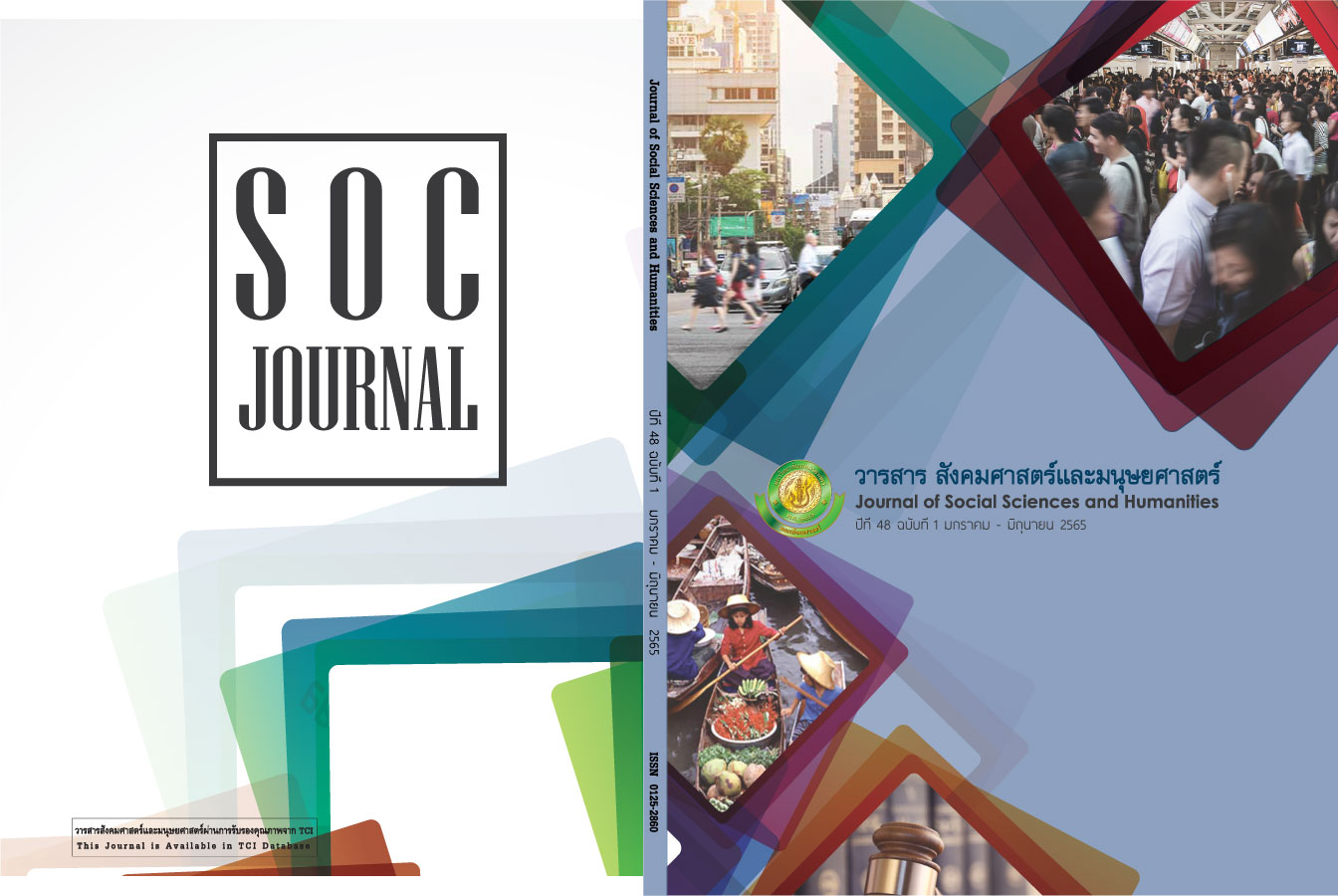การมีส่วนร่วมในการจัดการทรัพยากรป่าไผ่ชุมชนบ้านผาตูบ ตำบลผาสิงห์ จังหวัดน่าน
Main Article Content
บทคัดย่อ
การวิจัยครั้งนี้มีจุดประสงค์เพื่อ 1) ศึกษาข้อมูลพื้นฐานของชุมชนและทรัพยากรป่าไผ่ 2) ศึกษาการดำเนินงานของกลุ่มที่เกี่ยวข้องทรัพยากรป่าไผ่ และ 3) วิเคราะห์การมีส่วนร่วมของการจัดการทรัพยากรป่าไผ่ เป็นการวิจัยแบบผสมผสาน ประชากรที่ใช้ในการศึกษา คือ ประชาชนชุมชนบ้านผาตูบ ตำบลผาสิงห์ อำเภอเมือง จังหวัดน่าน จำนวน 143 ราย รวบรวมข้อมูลด้วยแบบสอบถามและการสัมภาษณ์เชิงลึกผู้รู้ (Key informants) จำนวน 13 คน ประกอบด้วย ผู้นำชุมชน ผู้นำกลุ่ม เจ้าหน้าที่ภาครัฐ เจ้าหน้าที่ท้องถิ่น ปราชญ์ชุมชน วิเคราะห์ข้อมูลด้วยสถิติพรรณนา
ผลของการศึกษา พบว่า ลักษณะทางภูมิศาสตร์และกายภาพของบ้านผาตูบตั้งอยู่ศูนย์กลางป่าอนุรักษ์และสำนักงานวนอุทยานถ้ำผาตูบ มีป่าชุมชนที่อุดมสมบูรณ์ด้วยป่าไผ่และความหลากหลายในพื้นที่ ประชาชนที่มีความสนใจเข้ามามีส่วนร่วมการจัดการทรัพยากรป่าไผ่ของชุมชนบ้านผาตูบ มีเพศหญิงร้อยละ 52.45 และเพศชายร้อยละ 47.55 ส่วนใหญ่มีอาชีพหลักคือการเกษตรร้อยละ 58.04 การดำเนินงานของกลุ่มที่เกี่ยวข้องกับไผ่ชุมชนบ้านผาตูบมี 3 กลุ่ม ประกอบด้วย กลุ่มจักสาน กลุ่มผู้สูงอายุ รวมทั้งกลุ่มอนุรักษ์ป่าและป่าไผ่ ทั้ง 3 กลุ่ม มีความเชื่อมโยงกันด้วยวิถีวัฒนธรรม มีการช่วยเหลือเกื้อกูลกันและแลกเปลี่ยนข่าวสารตลอดจนองค์ความรู้ มีโครงสร้างที่กำหนดบทบาทหน้าที่อย่างเป็นทางการเพื่อร่วมภารกิจในด้านอนุรักษ์ ป้องกัน และฟื้นฟู มีพันธกิจร่วมระดับตำบลและได้รับสนับสนุนจากหน่วยงานและองค์กรด้านการอบรม และงบประมาณ จากผลการมีส่วนร่วมการจัดการทรัพยากรป่าไผ่ 5 ระดับ พบว่า การมีส่วนร่วมคิดมากที่สุด คือ ระดับที่ 1 การมีส่วนเสนอความคิดการจัดสรรผลผลิตที่มีในป่าชุมชนผาตูบ โดยมีค่าเฉลี่ย (µ) เท่ากับ 4.90 ค่าส่วนเบี่ยงเบนมาตรฐาน (σ) เท่ากับ 0.30 ระดับที่ 2 การมีส่วนร่วมตัดสินใจมากที่สุด คือ ร่วมพิจารณาการแบ่งขอบเขตป่าไผ่แต่ละหมู่บ้าน โดยมีค่าเฉลี่ย (µ) เท่ากับ 5.00 ค่าส่วนเบี่ยงเบนมาตรฐาน (σ) เท่ากับ 0.00 ระดับที่ 3 การมีส่วนร่วมดำเนินการมากที่สุด คือเข้าร่วมดำเนินการสำรวจป่าไผ่ โดยมีค่าเฉลี่ย (µ) เท่ากับ 4.97 ค่าส่วนเบี่ยงเบนมาตรฐาน (σ) เท่ากับ 0.16 ระดับที่ 4 การมีส่วนร่วมรับผลประโยชน์มีระดับที่สูงที่สุด คือ ไม่ต้องจ่ายเงินหาหน่อไม้และลำไผ่โดยมีค่าเฉลี่ย (µ) เท่ากับ 4.90 ค่าส่วนเบี่ยงเบนมาตรฐาน (σ) เท่ากับ 0.30 ระดับที่ 5 การมีส่วนร่วมประเมินและติดตามผลมีระดับที่สูงที่สุด คือ มีส่วนร่วมในการตรวจสอบการเข้าไปหาหน่อไม้และลำไผ่มีค่าเฉลี่ย (µ) เท่ากับ 4.29 ค่าส่วนเบี่ยงเบนมาตรฐาน (σ) เท่ากับ 0.57 ตามลำดับ
Article Details

อนุญาตภายใต้เงื่อนไข Creative Commons Attribution-NonCommercial-NoDerivatives 4.0 International License.
เอกสารอ้างอิง
กมลทิพย์ เรารัตน์. (2560). ไผ่ความหลากหลายในวิถีชุมชน. เชียงใหม่: สถาบันวิจัยและพัฒนาพื้นที่สูง (องค์การมหาชน).
จินตวีร์ เกษมศุข. (2561). แนวคิดการมีส่วนร่วมของประชาชนเพื่อการพัฒนาชุมชนที่ยั่งยืน. วารสารศรีปทุมปริทรรศน์วิชาการมนุษยศาสตร์และสังคมศาสตร์, 26(50), 169-184.
นายิกา ใจดี. (2563). การพัฒนารูปแบบการจัดการสิ่งแวดล้อมบนฐานวิถีชีวิตชุมชนเพื่อเสริมสร้างชุมชนเป็นเลิศแห่งความรอบรู้ ด้านสิ่งแวดล้อมอย่างยั่งยืนของจังหวัดปทุมธานี. วารสารวิชาการสาธารณสุข, 29(1), 62-74.
บงกชมาศ เอกเอี่ยม. (2561). การจัดการความขัดแย้งด้านทรัพยากรการท่องเที่ยวของผู้นำชุมชนท้องถิ่นในจังหวัดเชียงใหม่. วารสารวิจัยและส่งเสริมวิชาการเกษตร, 36(3), 102-113.
ไพรัตน์ เตชะรินทร์. (2527).กลวิธีแนวทาง วิธีการส่งเสริมการมีส่วนร่วมของประชาชนในงานพัฒนาชุมชน. กรุงเทพฯ: ศักดิโสภาการพิมพ์.
แพรภัทร ยอดแก้ว. (2563). รูปแบบการดำเนินงานของหน่วยอนุรักษ์สิ่งแวดล้อมธรรมชาติและศิลปกรรมท้องถิ่นจังหวัดนครปฐม, งานประชุมวิชาการระดับชาติครั้งที่ 12 มหาวิทยาลัยราชภัฏนครปฐม จังหวัดนครปฐม. นครปฐม: มหาวิทยาลัยราชภัฏนครปฐม.
วันชัย วัฒนศัพท์. (2545). คู่มือการมีส่วนร่วมของประชาชนในการตัดสินใจของชุมชน. นนทบุรี: สถาบันพระปกเกล้า.
ศูนย์ฝึกอบรมวนศาสตร์ชุมชนแห่งภูมิภาคเอเชียแปซิฟิก. (2557). ไผ่กับวิถีชีวิตคนไทย: องค์ความรู้และรูปแบบการจัดการของท้องถิ่น. กรุงเทพฯ : ดูมายเบส.
สมศักดิ์ สุวรรณสุจริต. (2531). แนวความคิดการมีส่วนร่วมของประชาชนในการพัฒนาชุมชนเมือง. ท้องถิ่น, 8(9), 71 - 72.
เสวียน เปรมประสิทธิ์และคณะ. (2553). นิเวศวิทยาของไผ่ข้าวหลามเพื่อการใช้ประโยชน์จากไผ่ข้าวหลามอย่างยั่งยืนในพื้นที่จังหวัดน่าน. พิษณุโลก: มหาวิทยาลัยนเรศวร.
สุวิชาญ ทุนอินทร์และคณะ. (2562). ปัจจัยที่มีความสัมพันธ์กับการจัดการเพื่อการดำรงอยู่ของหมู่บ้านเศรษฐกิจพอเพียงต้นแบบในภาคเหนือตอนบน. วารสารวิจัยและส่งเสริมวิชาการเกษตร, 36(1), 68-74.
สำนักปลัดองค์การบริหารส่วนตำบลผาสิงห์. (2561). ข้อมูลตำบลผาสิงห์. น่าน: องค์การบริหารส่วนตำบลผาสิงห์.
อัยรวี วีระพันธ์พงศ์. (2560). การจัดการทรัพยากรร่วมของชุมชนท้องถิ่น: กรณีศึกษาชุมชนคลองลัดมะยมแขวงบางระมาด เขตตลิ่งชัน กรุงเทพมหานคร. วารสารรัฐศาสตร์ปริทรรศน์ มหาวิทยาลัยเกษตรศาสตร์, 4(2), 212-219.
CRS and MEAS. (2015). Managing natural resources: A smart skills manual. Baltimore, MD: Catholic Pelief Services.
Cronbach, L. (1984). Essential of Psychology and Education. New York: Mc - Graw Hill.
Krishnaswamy, A. (2012). Strategies and tools for effective participation innatural resources Management. Journal of Ecosystem and Management, 13(2), 1-13.
Likert, R. A. (1932). Technique for the Measurement of Attitude. Archives Psychological, 3(1), 42-48.
Smith, W. W. (1991). The AIC model concept and practice: Organization for development international institute. Washington DC: OD II Leroy.


